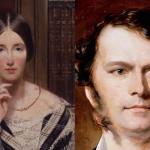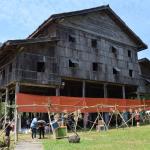Self-taught artist Mary Anne Vaz was born in Penang, but she has called Sarawak home since she married her Kelabit husband.
She uses various mediums in her art including batik, acrylic, water colour and pastels.
A prolific painter like one of her idols Vincent Van Gogh, her work has been exhibited in various places such as Lingnan Museum of Art in China, Pustaka Miri and Saradise Gallery, Kuching.
She now teaches both young and old from an art center at her home.
Not content to just paint, she, together with her art students, have started a social project whereby proceeds from sales of their paintings will go to buying story books for Penan children in Ulu Baram.
Recently, KajoMag had the opportunity to learn more about the artist behind the paintings and her inspirations.

KajoMag: I understand that you started your journey in art as early as six years old. What do you remember about your paintings as a kid and what made you want to paint?
Mary Anne Vaz: I attended kindergarten where my teacher, a Chinese man gave me a chance to paint. I painted myself climbing a tree. Then I watched my brother paint big canvases with oil paints. I developed a style that was similar to oil painting in that I used very thick paints.
One day my dad told me, “You won a gold medal.” The concept of winning was not in my experience and I replied “ I don’t want a gold medal.” Then, it appeared on TV and in the news. It was the Queens Gold Medal.
I didn’t have any art books or art teachers. All I had was paint, brushes and paper. But there was a book on the human anatomy. From there, I became interested in painting human figures. So, most of my artwork features human figures.
I am fascinated with the hornbill dances of the Orang Ulu. Several of my paintings are on the dances, tribal attire, and everyday life of the Kelabits. I have also painted the legends of the Kelabits.
Then, I met the famous tattoo artist Ernesto Kalum. I became fascinated with his tattoos and have painted three paintings featuring him, one of them being “Warrior of Peace”.
KajoMag: How would you describe your style as an artist? Are there any painters that you particularly look up to?
Mary Anne Vaz: I am a symbolic artist. My paintings all carry deep messages. For example “ Warrior of Peace” which features Ernesto without his tattoos, without the sword, conveys the message that a leader must lay down his weapons and be vulnerable in order to lead his people to peace and face a brighter future.
I painted this after the summit between Trump and Kim Jong Un. The USA and North Korea meeting was to me a step towards disarmament. This is true courage. A warrior with no weapon is a truly brave warrior.
I look up to several artists. The first one was Chuah Thean Teng, the Father of Batik, who showed that this traditional style of fabric painting could be fine art. I studied his techniques and created a style of contemporary batik with traditional processes.
The second one is Vincent Van Gogh. I collected books on him. He was a prolific painter and I identify with him as I am also a prolific painter.
The third one is Raphael Scott Abeng from Kuching. He inspired me as a friend and I find his paintings unique and witty social commentary.
The fourth one is Tan Wei Kheng. He is a dear friend; he stretched my first canvas and has always been supportive.
Pustaka produced an e-book on Tan Wei Kheng called Discover Sarawak and I was the researcher and writer of his art. He is also a symbolic artist; his paintings being social commentary and social documentation.
KajoMag: Are there certain places you feel most inspired to paint? If so, where?
Mary Anne Vaz: The place that most inspired me to paint was Bario. Twenty-nine years ago when my eldest son was born , my husband and I walked 12 hours through the jungle from Bario to Pa’ Mada to have the traditional name changing ceremony.
I remember the trees being tall and the floor of the jungle covered with a carpet of leaves. Later, I made a sketch of my father-in-law’s parang and its tree bark sheath.
I then painted it in contemporary batik style. It is now in the Sarawakiana collection of Pustaka Sarawak. I painted the fireplace in “Kelabit Lady” which was exhibited in China in the Lingnam Museum of Art in Foshan in October 2018.
KajoMag: Can you name the biggest lesson you’ve learnt from being a part of the Sarawak art industry?
Mary Anne Vaz: The biggest lesson I have learned in being part of the Sarawak Art industry is that an artist must be dynamic, keep learning and growing. No doubt skills with brushes are important, but digital skills are vital to share our art and connect across nations.
Being multilingual is also important. When I went to China I prepared myself by learning to speak Mandarin.
Alta Moda Sarawak is a good example of how artists are being dynamic. Coming together to move forward. The leaders in Alta Moda Sarawak have created a bridge to tomorrow.
KajoMag: Care to share your hope for young artists in Sarawak?
Mary Anne Vaz: My art studio in Miri grooms young artists from as young as six years old. So, my hope is that parents take art seriously.
Give your child a chance to use the correct tools to paint. Give your child a good art tutor to mentor his growth. Let young artists develop their own style. I am happy that in my studio there are several young artists with very high potential.
I share my own techniques with them and encourage them to have their own vision. Parents have been very supportive in giving them time and resources to grow. What we need is more opportunities to exhibit the work of young artists.
KajoMag: Tell us more about your social project to buy books and reference books for the Penan children in Ulu Baram.
Mary Anne Vaz: My students and I started sending books to schools in Ulu Baram with the help of a friend who travels there regularly.
Each time my students sell a painting for RM50, they voluntarily donate RM10 to buy a story book. I also buy books that promote early reading such as books using phonics.
I will put about 20 books in a bag and give to my friend who takes them to the teachers there.
When I sell my paintings. I also buy some books for this purpose. I am thinking that story books are a source of joy, different from school books.
The Penan children and other children who live far from town may not have a chance to enjoy story books. Besides these, I have also bought encyclopedias for them.
About Alta Moda Sarawak
Interested viewers can catch Vaz and her works during this upcoming Alta Moda Sarawak.
To be held from March 7-9 at the old State Legislative Assembly (DUN) Building in Kuching, 24 designers and brands will be taking part in this event which aims to highlight the many colours of Sarawak’s cultures and diversities.
Check more of Vaz’s works on her website or follow her on Instagram.





























